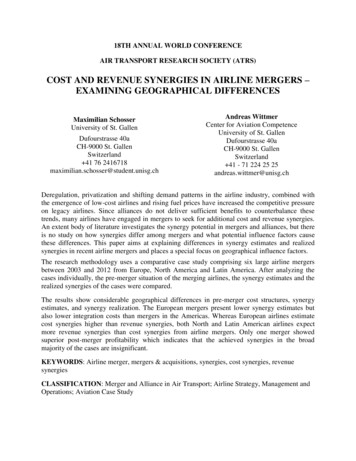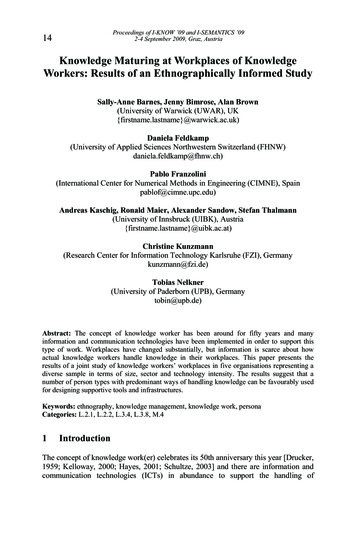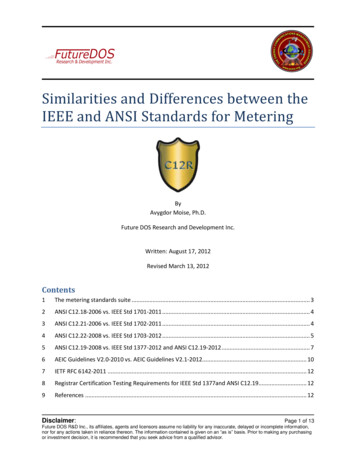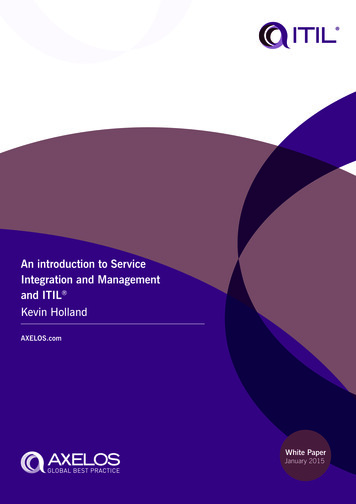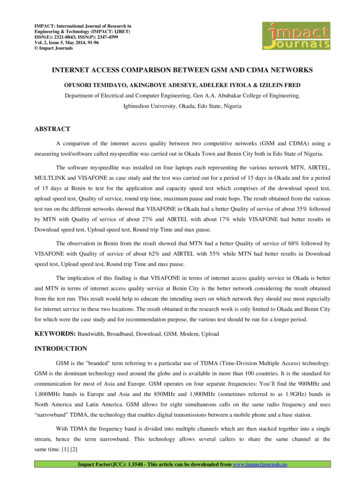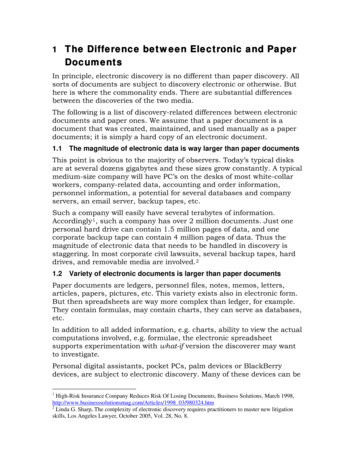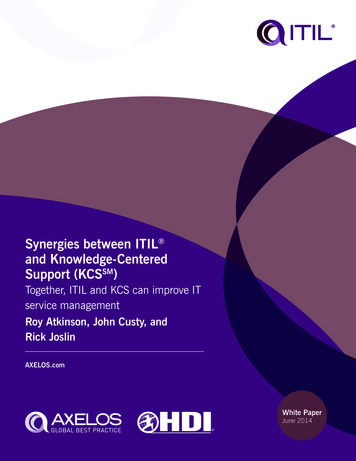
Transcription
Synergies between ITIL and Knowledge-CenteredSupport (KCSSM)Together, ITIL and KCS can improve ITservice managementRoy Atkinson, John Custy, andRick JoslinAXELOS.comWhite PaperJune 2014
2Synergies between ITIL and Knowledge-Centered SupportContents1Executive summary32Histories of ITIL and KCS53KCS complements the ITIL lifecycle64Summary12Appendix13About the authors14About AXELOS and HDI15Acknowledgements16Trade marks and statements16
Synergies between ITIL and Knowledge-Centered Support1Executive SummaryITIL provides guidance to service providers on the provision of quality IT services and on theprocesses, functions, and other capabilities needed to support them. ITIL provides a frameworkfor what needs to be addressed. Knowledge-Centered Support (KCS) provides detailed guidancefor capturing, structuring, reusing, and improving the knowledge articles that enable processes,functions, and other capabilities that improve a service provider’s efficiency and effectiveness.This contributes to the achievement of the business’s goals and objectives. Thus, KCScomplements the ITIL framework by providing a specific knowledge management methodology.ITIL is the most recognized framework for the set of practices known as IT service management (ITSM),which focus on ensuring the alignment of IT services with business needs. KCS is the set of bestpractices that focuses on the use of knowledge—especially within support—as a key asset in facilitatingthe achievement of business goals. KCS extends the knowledge management description as laid out inITIL’s Service Transition, and they share the same core objective: improving the quality of services andservice provisioning to support business processes.ITIL is intended to foster increased value of the services provided to customers, improved services thatmeet business needs, improved customer experience, satisfaction, and loyalty, improved employeesatisfaction and loyalty, improved productivity, and the continued ability to meet the needs of thebusiness. The practices described in KCS can facilitate and enhance the ways in which knowledge canbe used to accomplish these goals. Both ITIL and KCS continue to evolve to meet the changes faced byorganizations.Communications and meaningful processes are critical to service providers’ success. With regard toknowledge management, KCS utilizes a dual-loop process to describe its practices (Figure 1): a solveloop, including the Capture, Structure, Reuse, and Improve practices, and an evolve loop, including theContent Health, Process and Integration, Performance Assessment, and Leadership and Communicationpractices. ITIL organizes its processes into five lifecycle phases (Figure 2): Service Strategy, ServiceDesign, Service Transition, Service Operations, and overarching Continual Service Improvement.Adopting KCS can augment ITIL processes, adding specific methods for knowledge managementthat can assist in the processes themselves, as well as in overall efforts toward Continual ServiceImprovement. In order to derive the full benefits of KCS, “the organization must shift to a perspectivethat sees knowledge as an asset owned and maintained by the team, not by an individual or a smallgroup of dedicated content creators. The focus of the team is to capture and improve the collectiveknowledge—not only to solve individual customer issues, but also to improve organizational learning.”1While both ITIL and KCS are recognized as best practices that can help an organization achieve its goalsand objectives, as well as the business’s, neither ITIL nor KCS are the goals unto themselves.Whether adopting ITIL or KCS (or both), there are two similar challenges: first, putting them intopractice; second, integrating these practices with other frameworks and standards. The KCS practicesnot only complement ITIL, they’re also synergistic, providing guidance on how to capture, structure,reuse, and improve knowledge in order to improve the quality of the IT services delivered. KCS is notsomething extra that is done in addition to incident, request, event, or problem management; KCSprovides guidance on how the organization should integrate knowledge management with incident,request, event, problem, change, release and deployment, testing, and validation management.Consortium for Service Innovation, “KCS Practices Guide v5.3: KCS Benefits, Measures, and Phases of Adoption”(November 8, 2012), http://library.serviceinnovation.org/KCS Practices Guide/020/020.13
Synergies between ITIL and Knowledge-Centered SupportSOLVELeadership andcommunicationProcessintegrationEVOLVEFigure 1Structurermesto ceCu erienexpPerformanceassessmentCaptureim Prodpro ucvem tent4KnowledgereuseContenthealthReuseImproveThe KCS double-loop ervicestrategyServicedesignFigure 2The ITIL lifecycleServiceoperation
Synergies between ITIL and Knowledge-Centered Support2Histories of ITIL and KCS2.1 THE HISTORY OF ITILThe histories of ITIL and KCS share many similarities. ITIL was initially developed in the 1980s toensure that the UK government’s IT services were providing value and IT resources were being allocatedin a fiscally responsible manner. The ITIL framework addressed the management of these resourceswithout addressing any particular technologies. ITIL was subsequently updated in early 2000s,decreasing the number of books from forty-two to seven.As organizations began to understand the value of the framework, it was rapidly adopted by othergovernments and commercial organizations. However, they soon realized that training and certificationwere required for those individuals who would train and consult on ITSM using the ITIL frameworkas well as those who would work within organizations adopting ITIL. The Foundation certification,Practitioner certifications, and Manager certificate in ITSM were developed to meet this need.In 2007, ITIL evolved into the current lifecycle approach and a consistent qualification scheme:Foundation, Intermediate lifecycle and capabilities, and Expert and Master Certifications. The ITILframework was again updated in 2011 to clarify the lifecycle approach and evolve the framework basedon the lessons learned by practicing organizations.2.2 THE HISTORY OF KCSKCS was developed by the Consortium for Service Innovation, a nonprofit alliance of supportorganizations, as a methodology for improving both its members’ business operations and the customerexperience overall. The basic premise of KCS is the capture, structure, and reuse of knowledge.As a methodology and a set of practices, KCS focuses on knowledge as a key asset of the supportorganization. It has four basic concepts:Integrate the creation and maintenance of knowledge into the customer exception process. Evolve the knowledge based on demand and usage. Develop a knowledge base of the collective experience of the organization. Recognize learning, collaboration, sharing, and improvement.Until 2003, the KCS methodology was primarily available to members of the Consortium, and mostimplementations were highly customized. That year, HDI and the Consortium partnered to bring theKCS methodology to HDI members. KCS has been updated several times since—2003 (v3), 2005 (v4),2006 (v4.1), 2011(v5, v5.1), and 2013 (v5.3)—each update incorporating the experiences of KCSpractitioners. HDI and the Consortium then shared those experiences with the community.As with ITIL, as more organizations adopted the KCS methodology, the need for training and certificationbecame more apparent. The first KCS certification was introduced by HDI (in conjunction with theConsortium) in 2007. Similar to the ITIL certification schema, KCS has three levels of certification: afoundation level, which provides a basic awareness of the methodology and practices; an intermediatelevel for those who are developing the KCS practices; and an expert level.2.3 ITIL KCSWhile ITIL seeks to ensure that IT services are aligned with business goals, KCS focuses specifically onusing knowledge to support and realize these organizational goals and objectives. While ITIL’s primaryfocus is on IT service providers, the service lifecycle concept applies to all service providers (e.g.,hospitality, healthcare, human resources, facilities, etc.). The KCS methodology can also apply to and beused by IT support, customer support, and business unit support in any of these lines of business5
6Synergies between ITIL and Knowledge-Centered SupportAs ITIL and KCS were developedindependently of each other, someterms have different definitions.Customers in KCS are users in ITIL.In KCS, a customer exceptionrepresents any issue a user has whereassisted service or self-service couldbe used to provide a resolution (i.e.,enable the user to return to theiroriginal task). In ITIL, a customerexception could be an incident,request, or an event.Best practices continue to evolve and change based on theexperiences of the organizations using KCS and ITIL—or,more specifically, the experiences of people, the innovation ofprocesses, and the adaptation of technology to support changesin business needs. These adaptations are documented and sharedwithin the respective (ITIL and KCS) communities. The continueddevelopment of KCS and ITIL practices reflects the changingworld.Neither ITIL nor KCS is based on technology, yet both recognizethat technology enables processes and practices. To effectivelypractice ITIL, a service management toolset is required. Toeffectively leverage knowledge, it must be easily captured,structured, searched for, and reused. The same servicemanagement toolset used to record incidents and servicerequests, and manage events, changes, and releases, needs tobe integrated with knowledge across the organization. The degreeto which the technology supports ITIL or KCS can impact the effectiveness or maturity of the practices,but the organization’s success is not dependent on the technology; it is dependent on people and howthey use the technology. Technology can be an enabler or an inhibitor; it cannot ultimately determinesuccess, but it can enhance or limit an organization’s ability to improve the support it provides for itscustomers.2.4 KEY CHALLENGES FOR ITIL AND KCSITIL and KCS also share some fundamental challenges: in particular, changing the beliefs, attitudes, andbehaviours of people who have been in the same job and performing the same tasks for many years. Inorder for an organization to realize the benefits of either of these best practices, the people doing thework must change how they work. Best practices—including ITIL and KCS—can be transformational,resulting in real cultural and organizational changes.When we change how people do their jobs, we challenge the status quo, changing how organizationshave traditionally worked, how people have performed their tasks and activities, and even how theorganization structures and selects success indicators. People do not necessarily like change, andchanging how people do their jobs, using different indicators of success, and implementing differentsuccess metrics can be very stressful. Successful change requires leaders to have organizationalchange management competencies, and the same skills that help organizations adapt to, develop, andconsistently practice the ITIL lifecycle approach are also needed to implement and practice KCS.3KCS complements the ITIL lifecycle3.1 KCS AND SERVICE OPERATIONSWhether adopting ITIL or KCS—or both—Service Operations is probably where most organizationsstart, initially focusing on incidents and requests at the service desk. This is the easiest place to begin,as the operational improvements are easy to identify and can have a quick return on investment (ROI).Although it is the easiest place to begin, it may not be the appropriate place for any given organization.Each organization should consider where and how improvements produced by adopting ITIL and KCScan make the most difference.KCS can improve the service desk’s first contact resolution, handle time, and restoration time byproviding easily searchable, useable knowledge articles that contain advice, information, and guidancethat reduce downtime for users and improve service restoration time for requests. Knowledge reuseis even more valuable when it is implemented at levels 2 and 3, where the ROI can be even greater
Synergies between ITIL and Knowledge-Centered Supportthan that which can be realized at level 1. Fewer interruptions for the level 2 and 3 staff should resultin higher quality strategic projects, completed on time and on budget. KCS also provides guidance onmoving articles closer to the point of demand—from level 3 to level 2, level 2 to level 1, and level 1 tolevel 0 (self-service)—resulting in higher productivity for support and reduced downtime for users. KCSalso facilitates the creation of self-service articles in the context of the customer, which improving thosearticles’ findability and usability, and increases the ROI for the KCS investment.KCS isn’t something extra; it is how an organization does incident management, request management,and event management. It is how questions are answered, articles are reused, and experiences areshared. Organizations that practice KCS effectively integrate KCS into their ITSM processes.But KCS recognizes that not all knowledge articles are equal, and in a typical knowledge engineeringapproach (for support), only 20% of articles are reused. If an organization puts equal resources intoreviewing, editing, and publishing each article, then there is significant waste, as 80% of these articleswill not be reused. KCS is a demand-driven system; resources should only be allocated to improveknowledge when it is reused, not in case it is reused. Information from the knowledge system can thensupport problem, change, release and deployment, testing and validation, as well as business continuity,and can be a significant contributor to Continual Service Improvement.KCS and incident managementOne of the key incident management activities is incident matching, or the ability to reuse information inthe service management system to resolve similar issues faster. Incident matching isn’t feasible in mostorganizations, as the structure of the incident and request records does not lend itself to matching, andit would take too long if analysts tried. With KCS, knowledge is captured and made available for reuseduring the resolution process, simplifying the incident documentation process and creating records thatare more searchable, more readable, and more usable. The result is that searches will find the correctknowledge articles faster, reducing handle time and thus reducing downtime and improving productivityfor the organization. It will also provide a better foundation for the self-service article; consequently,more users will be able to find the article, which will, in turn, increase self-service utilization.Additionally, KCS recommends a structured problem-solving approach, which, when followed, increasesthe probability of finding a match. This results in improved documentation, decreased escalations, andincreased confidence in the support organization.In most organizations, incidents, requests, and events tend to recur. To provide the best service, thefollowing three steps are integral to improving performance, and they flow directly from KCS practices: Staff must first seek to find and use an existing knowledge article before they seek to solve the issueand create a new knowledge article. Seeking and finding existing, known articles will increase theconsistency of resolutions and workarounds, decrease downtime for the organization, and decreaseoverall support costs.I f the knowledge article is incorrect or could be improved, staff must take ownership for theimprovement. If they have the rights to modify the article, they are responsible to fix it (update theknowledge article). If they do not have the rights to modify the knowledge article, they must flag it.As part of flag it, they are also responsible for commenting on the article (including the reason why itwas flagged). Someone who has the authority to fix it completes the knowledge article modification.I f they do not find an existing knowledge article, then they should continue to follow the steps in theincident (request, event) process: investigate, diagnose, resolve, and recover. Once the resolution (orworkaround) has been identified, they add the new knowledge article so it is available for others toreuse.The key to this improved performance is the adoption of the Use It, Flag It, Fix It, Add It (UFFA) mindsetand the integration of these practices into the incident, request, and event management processes(Figure 3).7
8Synergies between ITIL and Knowledge-Centered SupportCreateincidentSearchknowledgebaseArticle found?NoResearch orescalateYesYesArticle correct?Solve itNoFLAG IT/FIX ITADD ITUSE ITClose incidentFigure 3The UFFA workflowKCS and request managementThe highest volume of contacts for most service desks is requests—providing advice or guidance—andKCS enhances the processes used by the service desk to document, track, and understand the type ofwork generated by requests. These requests can be for common, repetitive questions, business processadvice, or questions on standard operating procedures (SOPs). KCS supports request managementprocesses by making relevant knowledge articles available through self-service, which enables usersto better manage their time and achieve their goals by removing assisted support as a step in the pathtoward accomplishing their tasks.KCS and event managementKCS also provides consistent responses for Event Management. Typically, operations managementreceives a large volume of alerts for review, and often each has to be reviewed manually, withappropriate action then taken based on the specific error message. Consequently, analysts often developtheir own procedures for troubleshooting and verifying various events. KCS can provide a single-sourcerepository for operations management, with information on handling each type of alert consistently,following SOPs defined by technical management and operations management. Once this informationhas been documented, it can then be analysed by problem management, technical management, andapplications management to identify improvements, resulting in better service quality and increasedproductivity.
Synergies between ITIL and Knowledge-Centered SupportKCS and problem managementMany organizations struggle with Problem Management, dealing only with major incidents because theylack data and information about incident/request recurrence and are unable to link recurring incidents/requests to problems. With KCS practices in place, knowledge articles can be linked to problem records,or the articles themselves can contain the information Problem Management needs to understand thescope and impact of problems. Everyone in the support chain, through their use and/or reuse of articles,can improve the quality of information on problems, increasing the impact of Problem Management andthe quality of the services provided.In addition to faster resolution (through matching), KCS practices can provide information on articlesreuse, the cost of support, user downtime for each interruption, and the impact of each type ofinterruption on the business. This information can then be used to determine which problems shouldhave change requests (RFCs) and which problems should remain known errors (KEs)—no changesrecommended—due to cost or business priorities. The improved documentation in the incident, request,and event records, plus the information from the reuse of knowledge articles, can enable better ProblemManagement analysis and understanding of the organizational impact, risk, and cost of the recurringissues.Problem Management trending and analysis is often constrained by the quality of the incident records.With KCS, trend analysis shifts from incident classification to the reuse of knowledge articles, as eacharticle is linked to the incidents that were closed using that article. In a typical enterprise organization(without KCS), trend analysis involves analysing the classification structure within the incident record,which often isn’t appropriate for either incident or problem reporting. The result is that analysingincident records can be a complex task, and too often the classification data is inaccurate or incompletefor the needs of problem management. Knowledge article reuse can increase the efficiency andeffectiveness of trend analysis, allowing Problem Management to spend more time identifying rootcauses, developing fixes, and preparing changes.With each release, there should be a KE record for every bug, issue, or anomaly. These records needto be findable and usable, so that when someone contacts support with a question related to a KE,analysts can restore the service, provide the workaround, or add the issue to the list of symptomsfor that problem. Using KCS practices, organizations can stop rediscovering problems and recreatingsolutions each time a KE is reported.KCS and access managementIn an era of heightened cyber-security concerns, Access Management and its underlying processes andprocedures should be key areas of focus for organizations. Too often, however, knowledge managementis overlooked when it comes to Access Management. There are numerous policies, complianceprocedures, and work instructions involved in Access Management, and the ability to easily find thecorrect procedure or work instruction—and to know how often these are accessed—can provide security,access, and compliance management teams with the information they need to better understand theseconcerns as well as the costs of access management policies.3.2 KCS AND SERVICE TRANSITIONOne of the processes identified in the Service Transition phase is the Service Knowledge ManagementSystem (SKMS). The SKMS is a comprehensive approach to all of the knowledge needed for any ITILprocess, across all the lifecycle phases. KCS can be an essential component of any SKMS solution,providing data, information, and knowledge to inform core ITIL processes in Service Operation. As KCSmatures, information that can improve products and services can also be made available to ServiceDesign and Continual Service Improvement.9
10Synergies between ITIL and Knowledge-Centered SupportKCS and change managementChange Management is the control point, where the modifications that will be made to services,infrastructure, documentation, etc. are determined. There are often many questions when a change isbeing reviewed, specifically when the change or fix is in response to customer improvement requests.A change request that is tied to an existing knowledge article can leverage the knowledge article reusecounter (and links to the incident records) to better understand the organizational cost of not makingthe change, or the return on investment if the change is made. The creation and reuse of knowledgearticles related to a change can indicate the quality of the change, and this data should be included inthe post-implementation review. Thus, requirements for knowledge articles, as well as the update andmodification of existing knowledge articles impacted by a change, should be included in the changeapproval process.KCS and release and deploymentAs organizations plan releases and test deployments, they typically collect a significant amount ofinformation that is never captured for reuse, meaning that each successive iteration requires therecreation of solutions. Similarly, during the pilot phase of a deployment, release teams make a numberof discoveries about changes and releases; again, most often this information is not captured, resultingin continuing rediscovery vs. knowledge reuse. KCS practices enable the organization to quickly identifyand resolve recurring issues (as many issues are recurrences of KEs) and assist with the diagnosis andisolation of new issues by identifying similar issues and resolutions already captured in the knowledgebase.When KCS is integrated into release and deployment processes, the issues identified during testingand pilot phases can be documented with knowledge articles. Knowledge articles created during thesephases can then be made available for the release teams and the service desk at the time of generalrelease. (Training staff are responsible for creating knowledge articles when asked for guidance, advice,and information on the release.2) This knowledge can also be analysed and used to make appropriatereporting available on the quality of changes, as well as identify opportunities for improvement withinspecific technical and application areas.KCS and testing and validationWhile testing and validation are often modified to meet schedules, there is the potential for significantproductivity improvement with the use and/or reuse of knowledge articles, particularly with regard tocommon testing questions, repetitive set-up issues, etc. Testing and validation can be a significantsource of articles for reuse; the pilot teams and level 1 and 2 support can capture knowledge for issuesnot resolved prior to deployment.As with the Release and Deployment processes, KCS places the responsibility for capturing knowledgearticles identified in Testing and Validation with that process, minimizing the impact of any KEs andmaking this knowledge available for reuse.3.3 KCS AND CONTINUAL SERVICE IMPROVEMENTContinual improvement is fundamental to the KCS methodology: knowledge articles are continuallyimproved through reuse and improve, two of the KCS solve loop practices. Additionally, each personwho reuses an article is responsible for the quality of that article, in addition to quality monitoringconducted by coaches. KCS embodies the principles of continual improvement as it contributes to thebest utilization of resources, ensuring a positive return on the investment in KCS.While KCS does not promote the creation of articles in anticipation of a need, organizations sometimes proactivelydevelop knowledge articles based on their experience with similar releases, to minimize the impact of any issues onthe business.2
Synergies between ITIL and Knowledge-Centered SupportKnowledge articles are improved incrementally, as they are used. Doing this enhances the findabilityand usability of the articles, and ensures that resources are allocated only to those articles being used—which then have an increased likelihood of being reused. Knowledge is never modified in case it mightbe used; it is modified based on the actual reuse of knowledge articles.Continual Service Improvement deals primarily with service improvement plans (SIPs), which aregenerated whenever a service does not meet the agreed-upon levels, and ongoing service improvements,which are evaluated from the improvement register. Knowledge articles can facilitate data analysisin both areas. For recurring incidents and requests, the analysis of knowledge article reuse can helpContinual Service Improvement understand where there are reoccurring issues that might impact serviceavailability and user productivity. This analysis should also be an input for product management andproduct engineering, as part of a justification for an SIP or as part of an overall continual improvementplan.Many knowledge articles will provide advice, guidance, and answers to how-to questions. The reuse ofthese knowledge articles, as well as the reuse of knowledge articles linked to problems, should be keyfactors in product/service roadmaps, improving products and services based on the issues customershave experienced and reducing the cost of the downtime to the business. With training staff alsocontributing to the articles, better interfaces and online help can be integrated, improving the overallcustomer experiences.3.4 KCS AND SERVICE CONTINUITY MANAGEMENTThe goal of IT Service Continuity Management is to ensure that the required technical and servicefacilities (including computer systems, network, applications, data repositories, telecommunications,environment, technical facilities, and the service desk) can be resumed within required and agreed-uponbusiness timescales.3 Every change has a potential impact on the procedures, work instructions, andprocesses that would be used in the event of a failure; this is why continuity plans are required. No oneindividual could remember each change and its impact on recovery procedures, so updating knowledgearticles as part of the change, release, and deployment processes and testing continuity plans arecritical for an organization’s ability to respond.The detailed procedures in a continuity plan will be continually impacted by changes. Consistent withthe KCS methodology, knowledge articles can identify the activities necessary to restore services, whichcould—in the case of a failure that invokes continuity management—be different from day-to-day SOPs.Because continuity testing is typically infrequent, if an event requires the activation of the continuityplan, quick access to these procedures is necessary. Based on experience, organizations can forecastpotential issues and determine which issues should be mitigated and which should be addressed whenthe continuity plan is invoked. Knowledge articles can minimize the business impact and increase theprobability of following the correct procedure to restore the service.3.5 KCS AND SELF-SERVICESelf-service is defined as the ability of a user to complete tasks without the assistance of anotherperson. ITIL recognizes the need for and value of self-help, and how it can improve the performance ofincident, access, and request management. IT self-service sites are typically used for password resets,software and hardware requests, and responses to simple, repetitive requests for information, advice,and guidance. Unfortunately, these self-service sites are often frustrating to use, a
complements the ITIL framework by providing a specific knowledge management methodology. ITIL is the most recognized framework for the set of practices known as IT service management (ITSM), wh

